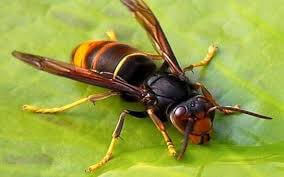Asian Hornet Watch App.
For easy detection of Asian Hornets, please download the
Asian Hornet Watch app to your smart phone/tablet!
Asian Hornet Watch is a citizen science smartphone app which allows users to monitor sightings of the invasive Asian Hornet species. The app, developed by CEH and funded by Defra, includes information on the ecology of the Asian hornet as well as details of species that are commonly confused with it.
Watch this YouTube video to understand more.
Note, there is no audio on this walkthrough video.
Asian Hornet Watch app for iPhone:
https://apps.apple.com/gb/app/asian-h…
Asian Hornet Watch app for android:
https://play.google.com/store/apps/de…
Stuart from the Norfolk Honey Company shows the difference between the Asian Hornet (Vespa velutina nigrithorax) and the European Hornet (Vespa Crabro)
Guide for the public. Click here.
Vespa velutina, the yellow legged hornet, commonly known as the Asian hornet, is native to Asia and was confirmed for the first time in Lot-et-Garonne in the South West of France in 2004. It was thought to have been imported in a consignment of pottery from China and it quickly established and spread to many regions of France. The hornet preys on honeybees (Apis mellifera) and other pollinators and disrupts the ecological role which they provide, damaging commercial beekeeping activities. It has also altered the biodiversity in regions of France where it is established and can be a health risk to those who have allergies to hornet or wasp stings.
In 2016, Asian hornets were discovered in the UK for the first time. Genetic analysis confirmed they were the same genetic population (Vespa velutina nigrithorax) as those which came from Eastern China to France. Although we cannot rule out the hornet arriving directly from the same area in China, we believe this is highly unlikely. Further discoveries were made in both 2017 & 2018, all from the same genetic source.

Appearance of the Asian hornet
The Asian hornet is smaller than our native hornet, with adult workers measuring from 25mm in length and queens measuring 30mm.
It’s abdomen is mostly black except for it’s fourth abdominal segment which forms a yellow band located towards the rear.
It has characteristically yellow legs and it’s face is orange with two brownish red compound eyes.
PDBKA AHAT
Petersfield Beekeepers has an Asian Hornet Action Team established to help residents and members with potential sitings of the Asian Hornet. Contact your local Asian Hornet Alert Team (AHAT) on 07531 901767. PDBKA Asian Hornet Action Team Procedure – Sept 19

Biology of the Asian hornet
Spring – In spring the queen emerges from hibernation, seeks out a sugary food source to build up energy to commence building a small embryonic nest. During construction of this primary nest, she is alone and vulnerable but she will rapidly begin laying eggs to produce the future workforce. As the colony and nest size increases, a larger nest is either established around the embryonic nest or they relocate and build elsewhere.
Summer – A single colony, produces an average of 6000 individuals in one season and from July to the end of November the Asian hornet may predate on honeybee colonies. Asian hornets can be seen hovering outside a hive entrance, waiting for returning foragers. This is the characteristic “hawking” behaviour. When they catch a returning bee, they will take it away and feed off of the protein rich thorax; the brood requires animal proteins which are transformed into flesh pellets and then offered to the larvae.
Autumn – During autumn, the nest’s priorities shift from foraging and nest expansion to producing on average 350 potential queens and male hornets. Only a small number of these potential queens will successfully mate and make it through winter. After mating the newly fertilised queens will leave the nest and find somewhere suitable to hibernate over winter. The old queen will die, leaving the nest to dwindle and die.

